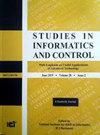Evaluation of Remote Data Compression Methods
IF 1.1
4区 计算机科学
Q4 AUTOMATION & CONTROL SYSTEMS
引用次数: 0
Abstract
: The present era is one of Big Data, digitalization, Internet of Things and Internet of Everything, which imply the daily creation of an enormous amount of useful content with a very high number of producers and consumers for the online information. The ascending trend for Internet data, has made clear the necessity of defining and engineering innovative solutions for coping with redundant transfers, which led to performing smart data transfers for obtaining an increased throughput, data availability and resource utilization and implicitly to a cost reduction and to avoiding bottlenecks and denial of service issues. Internet data employed by an Internet user must be consistent, so distributed systems are gaining research interest with regard to concurrency control, atomic transfers, data replication and synchronization, compression and decompression, correction or other potential problems. Two different versions of a file have a high similarity and as synchronization is concerned, the delta between the second version and the initial version of the file applied to its initial version will provide a better transfer throughput, thus an efficient data deduplication technique is necessary and worth analyzing in order to minimize the cost of synchronization. This paper focuses on optimizing the bandwidth utilization for remote data synchronization, and proposes a prototype based on three classic open-source data compression methods. The experiments carried out show how these compression utilities along with the transfer of data perform the synchronization of large data sets between two remote sites and how the use of compression helps to reduce the data size on storage devices along with decreasing the network bandwidth significantly. The novelty of this paper lies in the fact that it combines two different compression algorithms in order to provide better compression rates.远程数据压缩方法的评估
当前的时代是大数据、数字化、物联网和万物互联的时代,这意味着每天都有大量的有用内容被创造出来,网上信息的生产者和消费者数量非常多。互联网数据的上升趋势明确了定义和设计应对冗余传输的创新解决方案的必要性,这导致执行智能数据传输,以获得更高的吞吐量、数据可用性和资源利用率,并隐含地降低成本,避免瓶颈和拒绝服务问题。Internet用户使用的Internet数据必须是一致的,因此分布式系统在并发控制、原子传输、数据复制和同步、压缩和解压缩、校正或其他潜在问题方面的研究兴趣越来越大。一个文件的两个不同版本具有很高的相似性,就同步而言,第二个版本与应用于其初始版本的文件的初始版本之间的差值将提供更好的传输吞吐量,因此需要一种有效的数据重复删除技术,并且值得分析,以便将同步成本降至最低。针对远程数据同步的带宽利用率优化问题,提出了一种基于三种经典开源数据压缩方法的原型。所进行的实验显示了这些压缩实用程序如何与数据传输一起在两个远程站点之间执行大型数据集的同步,以及压缩的使用如何帮助减少存储设备上的数据大小以及显着降低网络带宽。本文的新颖之处在于它结合了两种不同的压缩算法,以提供更好的压缩率。
本文章由计算机程序翻译,如有差异,请以英文原文为准。
求助全文
约1分钟内获得全文
求助全文
来源期刊

Studies in Informatics and Control
AUTOMATION & CONTROL SYSTEMS-OPERATIONS RESEARCH & MANAGEMENT SCIENCE
CiteScore
2.70
自引率
25.00%
发文量
34
审稿时长
>12 weeks
期刊介绍:
Studies in Informatics and Control journal provides important perspectives on topics relevant to Information Technology, with an emphasis on useful applications in the most important areas of IT.
This journal is aimed at advanced practitioners and researchers in the field of IT and welcomes original contributions from scholars and professionals worldwide.
SIC is published both in print and online by the National Institute for R&D in Informatics, ICI Bucharest. Abstracts, full text and graphics of all articles in the online version of SIC are identical to the print version of the Journal.
 求助内容:
求助内容: 应助结果提醒方式:
应助结果提醒方式:


